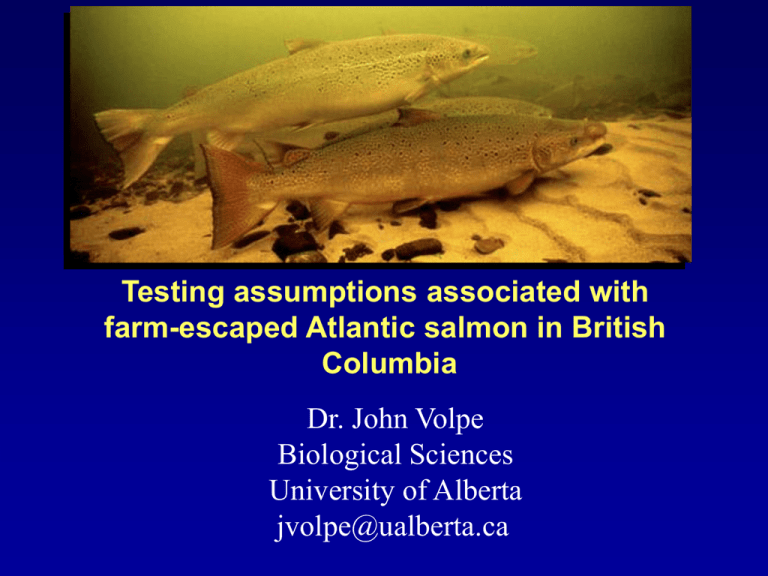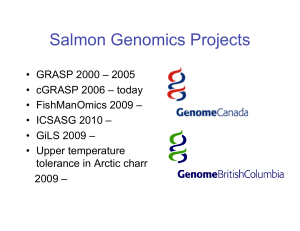Dr. John Volpe Biological Sciences University of Alberta
advertisement

Testing assumptions associated with farm-escaped Atlantic salmon in British Columbia Dr. John Volpe Biological Sciences University of Alberta jvolpe@ualberta.ca Issues • • • • Visual pollution (ecotourism) Site contamination (organic & pharmacological) Anti predator methods Disease transfer to / from wild salmonids • Ecological consequences of escapees 1905 5.5 - 13.2 M eggs + alevins released in B.C. Interspecific agonism (ST) 10 resistance factor 1934 Import of S. salar eggs for aquaculture 1984 1987 First capture of S. salar in B.C. waters 1991 First reported escape of S. salar 1995 SAR initiated SAR released First Atlantic salmon research on Pacific coast initiated 1997 Phase I research complete 2001 The Explanation Cascade Escapes of Atlantic salmon are rare Escapes of Atlantic salmon are inevitable but they won't survive in the wild Some Atlantic salmon may survive but will not ascend freshwater rivers Some adult Atlantic salmon are likely to be found in freshwater rivers but can't spawn Spawning is likely to occur but progeny will not be competitively viable And finally, the current position, There is no scientific evidence to show that the presence of feral juvenile Atlantic salmon in some rivers pose a threat to native populations. The Explanation Cascade Escapes of Atlantic salmon are rare Escapes of Atlantic salmon are inevitable but they won't survive in the wild Some Atlantic salmon may survive but will not ascend freshwater rivers Some adult Atlantic salmon are likely to be found in freshwater rivers but can't spawn Spawning is likely to occur but progeny will not be competitively viable And finally, the current position, There is no scientific evidence to show that the presence of feral juvenile Atlantic salmon in some rivers pose a threat to native populations. 0% Revenue loss resulting from escaped fish Retention of salmon in net pens 100% Cost of building / maintaining net pens According to DFO’s ASWP 396,552 Atlantic salmon have been reported as escaped 1991-2001 The Explanation Cascade Escapes of Atlantic salmon are rare Escapes of Atlantic salmon are inevitable but they won't survive in the wild Some Atlantic salmon may survive but will not ascend freshwater rivers Some adult Atlantic salmon are likely to be found in freshwater rivers but can't spawn Spawning is likely to occur but progeny will not be competitively viable And finally, the current position, There is no scientific evidence to show that the presence of feral juvenile Atlantic salmon in some rivers pose a threat to native populations. Atlantic salmon are commonly part of commercial salmon catches from Alaska to Washington No data are available regarding the source of these fish (physical or DNA tags) or period since escape and performance in the interim (otolith microstructure / stable isotope analyses) The Explanation Cascade Escapes of Atlantic salmon are rare Escapes of Atlantic salmon are inevitable but they won't survive in the wild Some Atlantic salmon may survive but will not ascend freshwater rivers Some adult Atlantic salmon are likely to be found in freshwater rivers but can't spawn Spawning is likely to occur but progeny will not be competitively viable And finally, the current position, There is no scientific evidence to show that the presence of feral juvenile Atlantic salmon in some rivers pose a threat to native populations. Atlantic salmon have been reported in 77 BC streams and rivers Atlantic salmon are now part of the terrestrial food web via predation Th e Explanation Cascade Escapes of Atlantic salmon are rare Escapes of Atlantic salmon are inevitable but they won't sur vive in the wild Some Atlantic salmon may survive but will not ascend freshwater rivers Some adult Atlantic salmon are likely to be found in freshwa ter rivers b ut can't spaw n Spawning is likely to occur but progeny will not be competitively viable And finally, the current position, There is no scientific evidence to show that the presence of feral juvenile Atlantic salmon in some rivers pose a threat to native populations. Tsitika River August 18 1998 •58 m channel •Heterogeneous habitat •30 females; 20 males transplanted without acclimatization • 1/3 females spawned • Spawning initiated in mid January Spawning Chronology Chum Little Qualicum Atlantic Salmon Sockeye Sept Oct Pink Nov Steelhead Dec Jan Feb Mar Coho Chinook Wild Atlantic salmon in native range Apr May 0+ • • • • 1+ Natural reproduction Two year classes present (0+ & 1+) ~50 juveniles identified to date Sympatric with strong steelhead population 0+ AS 0+ ST 1+ AS Mean Fork 63.75 ±3.3 55.42 ±5.81 119.25±5.52 Length (mm) 1+ ST 92.59±10.46 Mean Weight (g) 2.94±0.60 1.91±0.54 19.61±4.01 8.67±2.75 Mean CF (g x 100)/cm3 1.12 1.16 1.12 1.10 33 8 33 n 4 Feral Atlantic Salmon populations in Vancouver Island Rivers Port Hardy Tsitika R. Eve R. Amor de Cosmos Cr. Campbell R. <1% potential spawning and rearing habitat has been surveyed on Vancouver Island. Coastal mainland systems remain entirely uninvestigated.......? Port Alberni 100 km Nanaimo Tofino Victoria T he Explana tion Cascade Escapes of Atlantic salmon are rare Escapes of Atlantic salmon are inevitable but they won't su rviv e in the wild Some A tlantic sa lmon may survive but will not ascend fresh water rivers Som e adult Atlantic salmon are likely to be found in fr eshwa ter rivers but can't spawn Sp awning is likely to o ccur b ut proge ny will not b e comp etitively viab le An d finally, the curr ent position, There is no scientific evidence to show that the presenc e of feral juvenile Atlantic salmon in some rive rs pose a thr eat to native populations. Wetted area: 2.2m x 0.6m x 0.9 m Coarse river cobble (19.4 5.6cm) ~ 10% replacement per hour Flow 0.85 ms-s (4542.5 L min-1) 10 hp centrifugal pump Water temp maintained by a 240V, 60amp chiller Clear Lexan viewing windows Natural prey provided by a unique “upweller” feeding system Treatments High Forage 4 AS 4 AS 4 ST 4 AS 4 AS aAA aS A 4 AS 4 ST • High / low forage 4 ST 4 AS 4 ST 4 ST Response Variables assembly • Growth Low Forage 4 AS 4 ST 4 AS 4 AS 4 ST 4 ST • Density • Intra- / interspecies comp. • Assembly of “community” 4 AS • Foraging • Agonism (action + result) • Territory size a = comp. coefficient (Δ g) A = Atlantic salmon aSS aAS S = Native Steelhead 4 ST 4 ST ST on average engage in agonism 5:1 over AS ST show agonistic bias towards other steelhead 2 : 1 AS show bias towards steelhead 2.2 : 1 Therefore, steelhead are agonism targets, Atlantic salmon are not Of all treatment combinations the only consistent and significant predictor of performance is assembly order Residents with 3 days prior residency performed better than challengers under all conditions - regardless of all other parameters Atlantic salmon - residency + residency Perform well relative to steelhead Perform poorly relative to steelhead 1905-1934: Very low likelihood of establishing prior residency in Vancouver Island rivers Today: Vancouver Island steelhead populations are at ~ 10 - 20% of historical abundance Potential for successful colonization is likely much higher today than during historical intentional introductions Are production fish capable of spawning? YES Are juvenile Atlantic salmon competitively viable? YES (qualified) Are such conditions present in coastal B.C.? At present YES Historically NO Sufficient spawner densities for natural reproduction? YES Presence of feral populations? YES (3) Feral individuals perform as predicted? YES Prognosis? Pink salmon smolts June 2001 Sea lice are native however the density of farms may act as bio-magnifiers of parasites and disease such that the migratory habitat becomes saturated ie. pink smolt run The Explanation Cascade Escapes of Atlantic salm on are rare Escapes of Atlantic salmon are in evitable but they won't survive in the wild Some Atlantic salmon may survive but will not ascend freshwater rivers Some adult Atlantic salmon are likely to be found in freshwater rivers but can't spawn Spawning is likely to occur but progeny will not be compet itively viable And finally, the curr ent position, There is no scientific evidence to show that the presence of feral juvenile Atlantic salmon in some rivers pose a threat to native populations. There is no scientific evidence to show that the presence of feral juvenile Atlantic salmon in some rivers pose a threat to native populations. There is no evidence that salmon aquaculture as currently practiced in BC will not result in serious harm to native salmon populations or their environment. Principle 15 of the 1992 Rio Declaration on Environment and Development (to which Canada is a signatory) explains the precautionary principle as, "Where there are threats of serious or irreversible damage, lack of full scientific certainty shall not be used as a reason for postponing cost-effective measures to prevent environmental degradation." 1) all reasonable actions must be taken to protect the environment 2) inherent to this statement is the understanding of “reverse onus” - the burden of proof lies with industry to satisfactorily demonstrate their activity is not detrimental to the environment. The burden is not on the public to demonstrate the opposite



